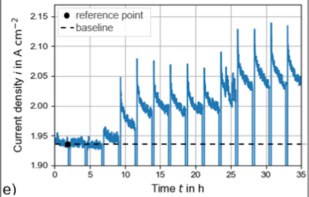
There has been much talk about green gas. It comes in various forms, the most obvious being biogas — biomethane made by the anaerobic digestion of bio-materials, including wastes. But there are also synthetic gases, for example hydrogen made from fossil gas by steam reformation (SMR), backed up by carbon capture and storage to make its production lower carbon. As yet less developed, there is also zero-carbon hydrogen made using renewable electricity, via electrolysis, that can be converted into methane and other synfuels — the so-called “Power to Gas” route (P2G).
In previous posts, I have looked at the ongoing debate over which route to take for delivering home heating: the SMR + CCS route is favoured at present but only as a back-up to direct electricity supply, used to run heat pumps. Biogas supplies are thought to be insufficient and P2G is seen as too expensive although, as I have reported, both those views have been challenged — there are already 1 million domestic biogas users and P2G hydrogen is being talked up. There are also other less developed routes. A German company is looking at high-temperature pyrolysis of fossil gas.
There is also a debate as to whether green gas, from whatever source, delivered via the gas grid is a viable alternative to delivering power via the electricity grid for home heating. It does have some key attractions — the gas grid in the UK handles around four times more energy than the power grid. The latter would have to be expanded significantly if we were to try to use it for heating. Gas is also much easier to store than electricity; the gas grid itself acts as a store so it can deal with variable demand more easily. And energy losses in transmission are lower.
Gas leaks
However, there are problems. Gas grids can and do leak (this amounting, for example, to over 2% of US gas production) and releasing methane into the air is a major climate issue – methane is a much more powerful greenhouse gas than carbon dioxide. It has a half-life of about seven years in the atmosphere before it is oxidized to carbon dioxide. Hydrogen is also a problem. H2 is a smaller molecule than methane (CH4) and can find its way through cracks and seals relatively easily; it can also lead to embrittlement of metal pipes. The UK has replaced most, but not yet all, of its old iron gas pipes with plastic pipes. So the gas grid system may not be able to safely or securely handle even medium levels of hydrogen mixed in with the methane (e.g. a 20% mix), much less 100% hydrogen as some, like the H21 project in Leeds, want. At least, not yet. A new report from the UK Institution of Engineering and Technology claims that, when the gas grid has been fully upgraded, full conversion to 100% hydrogen delivery should be viable in safety terms, but it does not address the leaks issue, apart from saying they would not occur near homes.
Safety apart, the potential for leaks matters. Hydrogen has a much lower greenhouse gas impact potential than methane, which has around 86 times the impact of carbon dioxide on a 20-year timescale, but its impact is still, I’m told, around 4-9 times that of carbon dioxide. So switching from methane to hydrogen will help but it is still an issue if it leaks more, e.g. via seals and fractures.
As the use of shale gas has expanded in the US, there has been more work done on the emissions it involves, including so-called fugitive emissions and transmission losses, so now we know more about the problems of methane distribution and use. It is certainly sobering — natural gas no longer looks like a clean interim energy option. But as yet it’s not clear what exactly we would be faced with if hydrogen is used as a new energy vector and distributed via a gas grid. Although it said more research was needed, a recent short UK government Department for Business, Energy and Industrial Strategy (BEIS) review saw hydrogen release as potentially having low impact on the atmosphere/climate, and the leakage issue may not be too significant relative to methane; it ought to be possible to limit it by installing better seals and pipework. However, that may add costs, and if pipe leaks turn out to be a major issue, it may be better to focus more on local hydrogen generation, storage and use where possible, so minimizing long pipe use. For example, for balancing purposes, it may be possible to have large P2G plants near major renewable sources such as wind farms, tidal farms and hydro, with local large-scale hydrogen storage in salt caverns, and to use the hydrogen to make power when needed for distribution elsewhere by the power grid. That may be credible in some locations but not for many – not everywhere will have large renewable sources and although large underground storage is cheaper than tank storage, it is very site-specific and there are limited sites. However, liquid air storage might help as it is not location-defined.
So we might have some local P2G/gas storage power hubs. We might also even have some SMR+CCS power hubs, if there is enough fossil gas and we can accept the lower SMR conversion efficiency, and if there are carbon stores reasonably nearby. However, that seems to add yet another constraint and another layer of complexity. P2G is more location-flexible and doesn’t need gas or CCS. It also circumvents the issue of methane leaks that would be associated with SMR. So, in parallel with large hubs, we could also have smaller local hydrogen generation and storage, closer to users, with shorter dedicated hydrogen grid links, circumventing the issue of hydrogen leaks.
Does all this mean that we should abandon long-distance gas or hydrogen transmission? No, since the energy losses in power grid transmission are high – so, if it was green power being used, we would be losing valuable carbon-free power. Gas transmission can avoid much of that and, even with leaks, can still in some cases translate to better delivery of low- or zero-carbon power, with easier storage. The leakage issue does, however, need addressing if the future energy system is to depend heavily upon a gas grid. But at least for P2G hydrogen, it should not be an economic show-stopper longer term. It has been claimed that P2G will be competitive with SMR/CCS within a decade or so. If that is the case, by then, if we sort out the pipework, we should be able to pipe fully green hydrogen long distances without leaks.
Whether a green gas grid can or should replace, or just augment, an enhanced power grid transmission remains to be seen; my guess is that, along with some local heat distribution, we will always need both, with HVDC supergrids still being the best option for very long-distance transmission. But, while the SMR+CCS route to hydrogen production does look costly and inefficient in terms of greenhouse gas emissions, and P2G is moving ahead, the debate over whether hydrogen should play more of a role goes on. The alternative is, of course, to expand and upgrade the power grid beyond what the Committee on Climate Change seems to have in mind for the UK (around 600 TWh capacity by 2050), along with a bit of SMR/CCS hydrogen use for peak heating. Will that be possible, and sufficient, for achieving a balanced, zero-carbon system?



